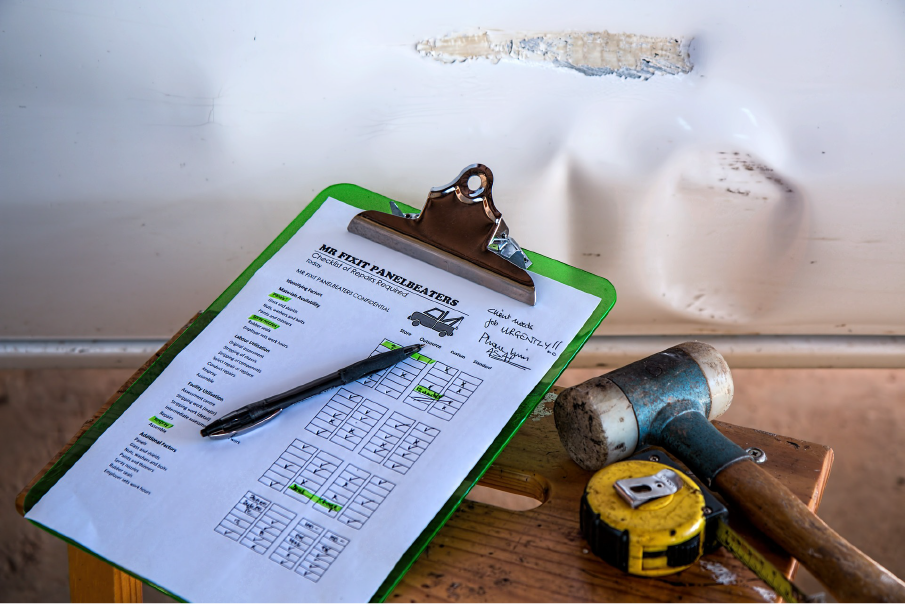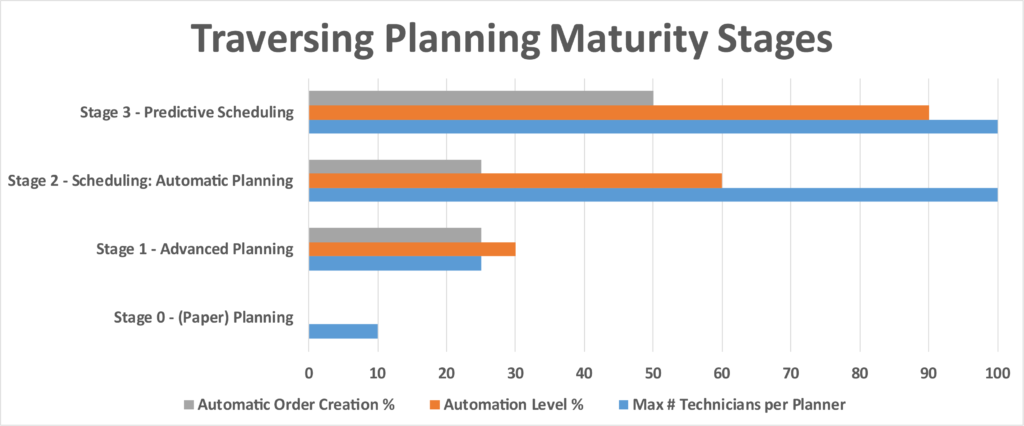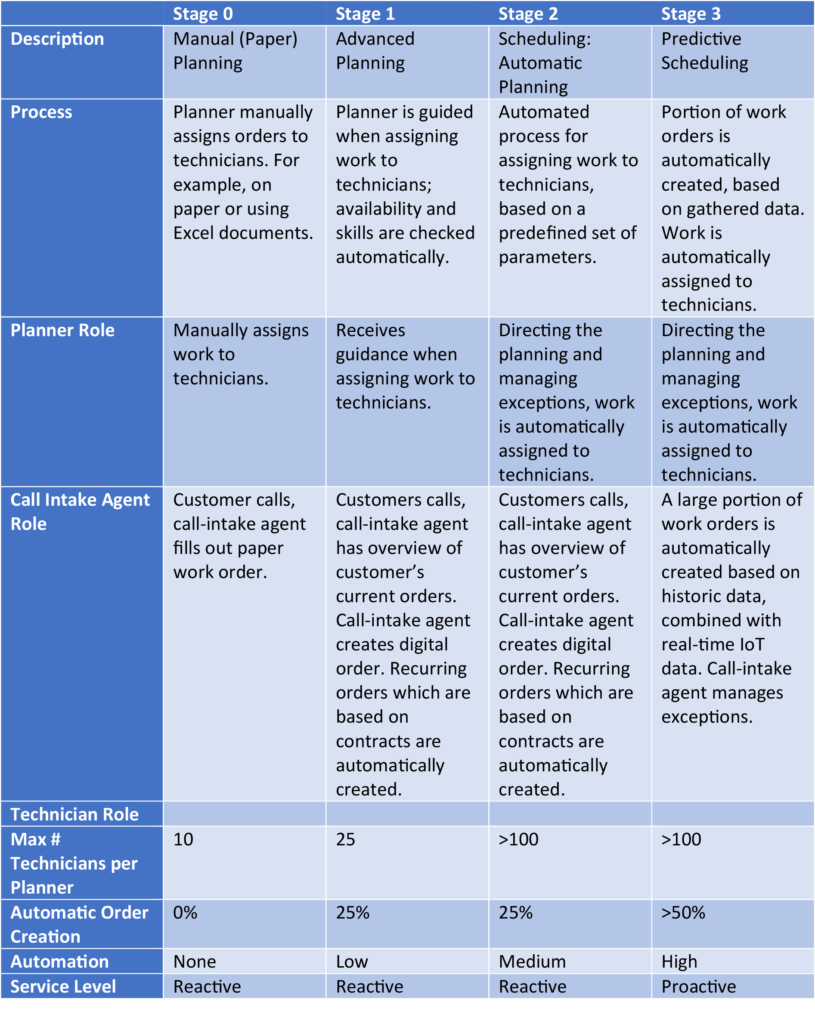
Editor's Note: This post was originally published on March 7, 2019, and updated for accuracy and comprehensiveness.
In previous blog posts, we’ve discussed the benefits of moving to the cloud and the need for offline support in your field service solution. In this post, we will share insights on another critical feature of a field service solution: planning. Technicians are assigned work orders in the field during the field service planning process. The planner plays an integral role in this process, and as the planning process matures, the part of the planner shifts from planning optimizer to planning director.
With decades of experience in field service, the Gomocha team has identified four stages of maturity in the planning cycle, including the requirements and benefits of advancing to the next stage of maturity.
While you traverse the different maturity stages, your organization will mature and reap benefits. These benefits include increased customer satisfaction, lower operational costs, and higher employee satisfaction. All of which help ensure you can stay ahead of your competition.
Planning in Field Service
Assigning work orders is one of the most important processes in field service. But, to assess your organization’s efficiency, it is essential to consider the level of effort and complexity required to manage workers.
The planner’s work is directly related to call intake agents and technicians. However, those roles differ as follows:
Call intake agent:
- Receives call from a customer
- Assesses customer needs
- Creates work orders
Planner:
- Assigns work
- Re-assign work orders when they take longer than expected
- Re-assign work orders when a technician is sick or unavailable
- Keeps track of all work orders
Technician:
- Executes work orders
How Mature is Your Organization’s Planning Process?
Gomocha has identified four stages of maturity in the planning cycle, including the requirements and benefits of advancing to the next stage of maturity.
Stage 0 – Manual Planning
Suppose you follow manual (paper) processes. In that case, you are at “ground zero” in your planning maturity, where planners typically handle the assignment and re-assignment of work orders. Call-intake agents manually create all work orders, usually by filling out a paperwork order. This paperwork order goes to the responsible technician, who returns it with the customer’s signature after job completion. A field service solution is usually not in place in this scenario.
Stage 1 – Advanced Planning
In this stage, a field service solution supports the call-intake agent, planner, and technician. When the customer calls, the call-intake agent gets an overview of all customer data – including the latest orders, contracts, and assets. In addition, you can view work order information and specific order details. Finally, you can use contracts to set up recurring orders. For example, two preventative maintenance checks per year automatically generate in the solution; therefore, a call-intake agent is no longer involved.
The planner’s role in Stage 1 also differs from that of planners in Stage 0. In Stage 0, a planner would need to consider the technician’s availability, skills, the skills required for a specific job, any time constraints (SLA) on order, the territories involved, and much more. With the advanced-planning capabilities in a field service solution, a planner would receive warnings when the work assignment does not match the criteria. Therefore, it allows for semi-automatic optimization. As a result, a planner can plan more technicians. Furthermore, it is easier to transfer work between planners since knowledge is in the field service solution.
Another benefit of the advanced-planning capability is that it enables planners to transfer workloads from one technician to another in the event of, for example, technician illness or other emergencies.
Stage 2 – Scheduling: Automatic Planning
The planner’s role changes when you switch from advanced planning to scheduling. With advanced planning, it’s the planner’s task to plan all work orders. With automatic planning, the scheduling algorithm executes this task. Therefore, automatic work orders shift the planner’s role to a director or exception manager. For example, if a technician gets sick, a planner will ensure the scheduler is aware of this so that they can reschedule work orders.
Since the scheduling algorithm uses several optimization algorithms – such as route optimization, SLA optimization, environmental optimization, etc. – the resulting planning is automatically optimized based on the parameters of the optimization algorithms. As a result of automation, a planner can manage hundreds of technicians. When a customer requests to plan or reschedule a work order, the scheduling engine can be used as an “advice agent” to propose some options – taking SLA, technician skills, availability, tools, territories, contracts, and cost into account. The same holds for high-urgency and emergency orders, which arrive when all technicians are already fully booked. The scheduling algorithm finds an open spot by rescheduling an already-planned work order to another time.
Stage 3 – Predictive Scheduling
You’re at the top of the planning maturity scale (Stage 3) if you’re using a solution that helps you predict when work is assigned, which helps avoid emergency-repair situations and helps minimize downtime.
The planner’s role in Stage 3 is similar to that of Stage 2 – generally a director and exception manager. The big difference is the manual work manually created by the call-intake agent, which drops significantly in Stage 3. A large percentage of the orders are made based on real-time IoT data in combination with historical data. Predictive maintenance orders are planned based on the actual use of assets instead of on a preset maintenance schedule. As a result, the number of service requests declines. In case of an unforeseen failure, the asset will automatically report that it has failed, resulting in an automatically created service request.
For a call-intake agent, their role also shifts to an exception manager. The field management solution automatically creates a large percentage of work orders. In some cases, however, some assets or customers may not yet have IoT capabilities. In other instances, certain customer-specific restrictions may preclude fully automated scheduling, such as a lack of access to the property without the customer being present. Those scenarios still require a call-intake agent’s directions.
As You Grow, FMP360 Grows with You
The FMP360 Platform is a stackable solution that enables your field service organization to change and grow through the planning maturity stages. For example, you start using FMP360 for advanced planning. Then, when your organization matures and you need more functionality, you can quickly move to Stage 2, the scheduling solution, by adding (or “stacking”) another module on your existing solution.
You can move to Stage 3, predictive scheduling, when your organization is ready. Our stackable solution does not need to replace your field service solution. When you grow, our FMP360 Platform grows right along with you.
A Trustworthy Solution is the Ideal Change Agent
Don’t go from first gear to sixth gear. Instead, take a measured approach to change. First, of course, your organization needs to adapt to changing circumstances. Recognizing and accepting that the planners’ role is changing is the first step in transitioning up the planning-maturity scale. Instead of the traditional approach, the future is all about planners using their organizations’ digital solutions to handle the “heavy lifting” associated with increased efficiency and improved profitability.
Need Advice and Guidance?
For more than 33 years, Gomocha has provided advice and guidance to field service organizations. We’re experts at designing roadmaps to take companies from “ground zero” to Stage 3, with any necessary stops along the way to ensure that steady progress will lead to success. Request a demo, call 240-403-6001, or email fmp360@gomocha.com to share your story and tell us how we can help you.


